On this page I show the sculpture projects which I am working on or have completed in Spring and Summer 2010.
I have made many sculptures based on torus knots, generatizations of the umbilic torus developed by Helaman Ferguson. Since those made from wood came out so well, I decided to try making some even larger ones carved of stone. I got two 9" x 9" x 3" pieces of alabaster from Stone Sculptors Supplies in California, and prepared them by rounding off the corners and drilling out a 3" diameter cylindrical hole in the center. They did not come as nicely cut rectangles the way the wooden pieces came, so I also had to do some rough sanding to flatten the faces before beginning serious carving. Working on these stones produced a large amount of stone dust, like talcum powder, which got all over everything in my workshop, even with a fan taking dust out of the room. I did some of the work with air-powered equipment in the university sculpture studio over a work station equiped with better dust controlling fans. The first three pictures below are of the first piece I finished polishing on Feb. 14, 2010. It is the same pattern, a (5,4) torus knot, as the cocobolo torus knot completed in Fall 2009, whose cross section is the k = 4 hypocycloid, and whose parametric equations have been given on the Fall 2009 sculptures webpage.
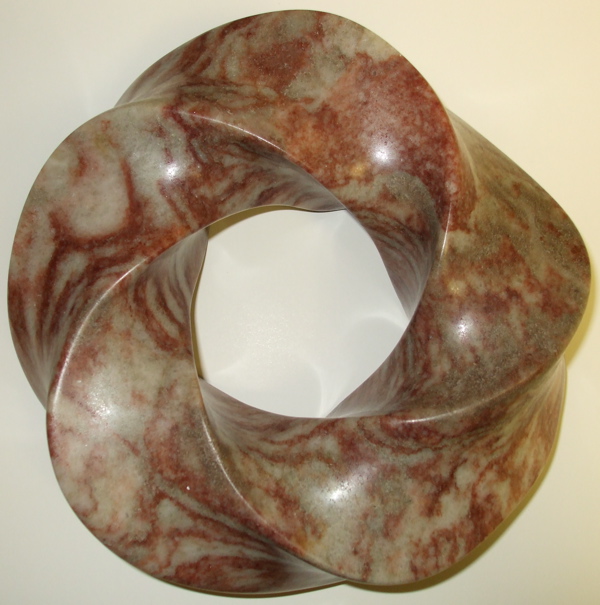
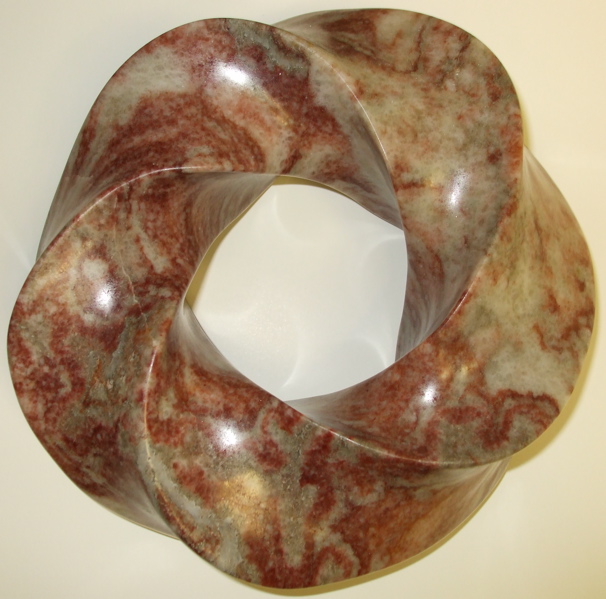
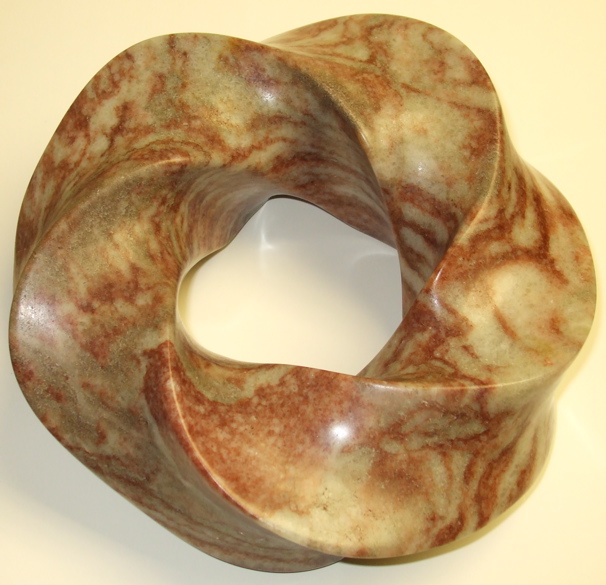
The next four pictures are of the second alabaster piece I finished on March 6, 2010. It is a (5,3) torus knot whose cross section is the k=3 hypocycloid. Unlike earlier wooden carvings I did, this one is more regular and does not emphasize a pentagon on the outside. Both pieces are approximately 9" in diameter and 3" thick. I will later design a support to hold and display these pieces.
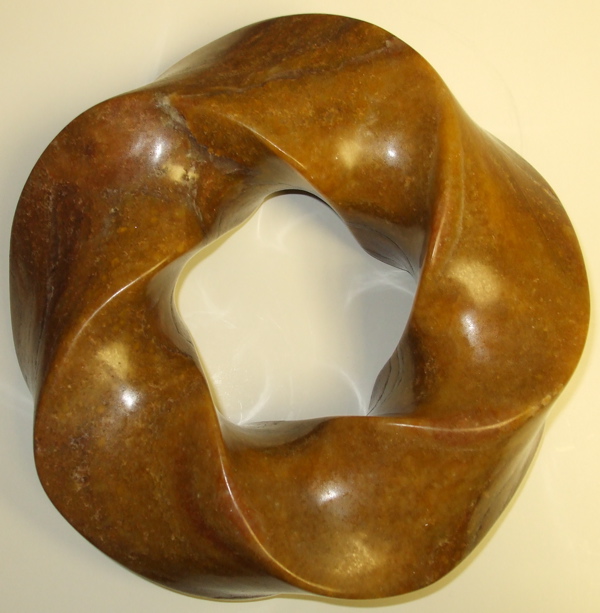
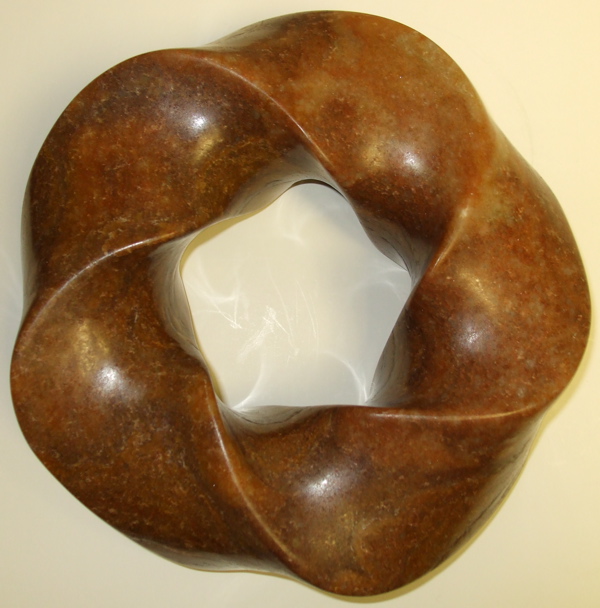
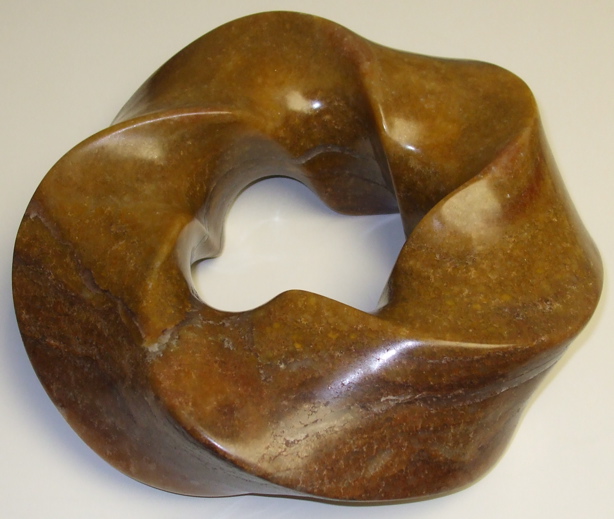
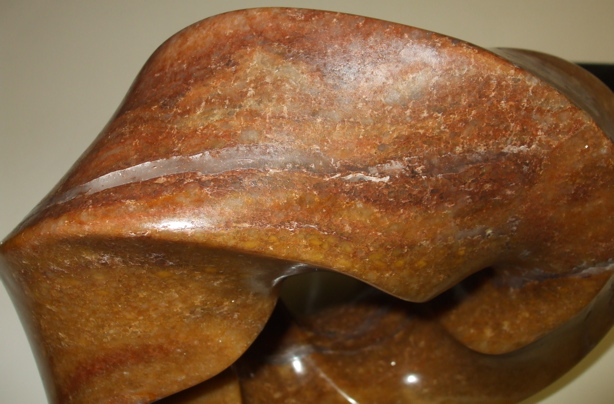
I have made a larger version of the aluminum operad sculpture shown earlier. This one is 24" in diameter, 1/2" thick, and its inner disks move on stainless steel ball bearings spring loaded in each inner disk. A threaded steel 1/4" diameter rod goes into the edge of the disk and into a 3/4" diameter aluminum rod which will hold the sculpture in a vertical position. That rod will slide into a stainless steel tube which will be embedded into a concrete pillar topped by a 10" diameter aluminum disk (a cutout which made the 10" hole in the main sculpture). Below are pictures with the moveable disks in a particular position.
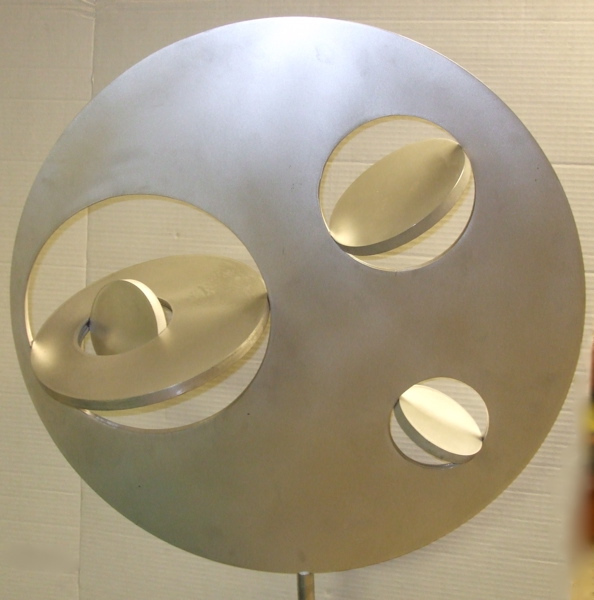
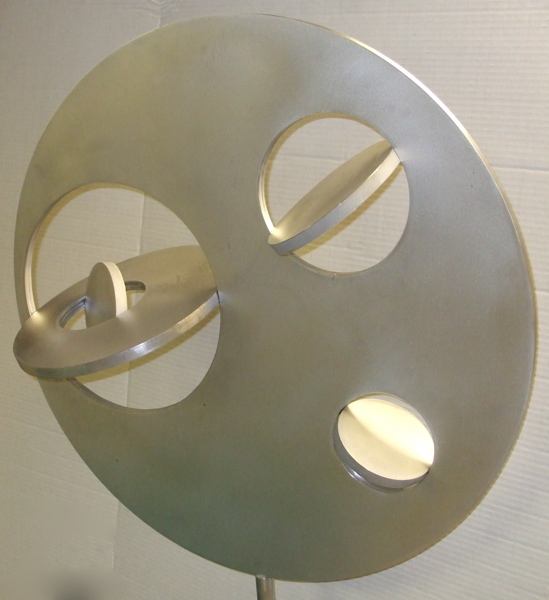
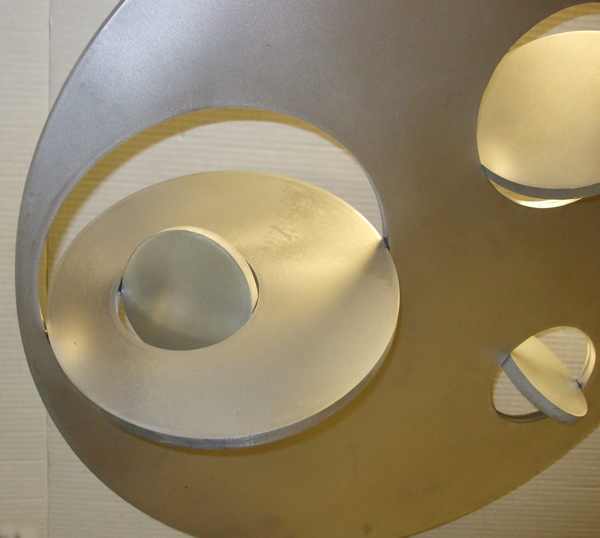
On an earlier page I showed pictures of the cast bronze version of the small operad sculpture. I had some difficulties completing it because it was not precisely cut from a sheet of metal with uniform thickness. The casting process made a disk of uneven thickness, so that is was difficult making the grooves in which the ball bearings would roll. But I did the best I could, and mounted it on a block of marble, which I carved a bit into an uneven rectangular shape. One has to be careful when moving the positions of the disks, because some of the spring-loaded ball bearings could pop out of their grooves. Here are two pictures.
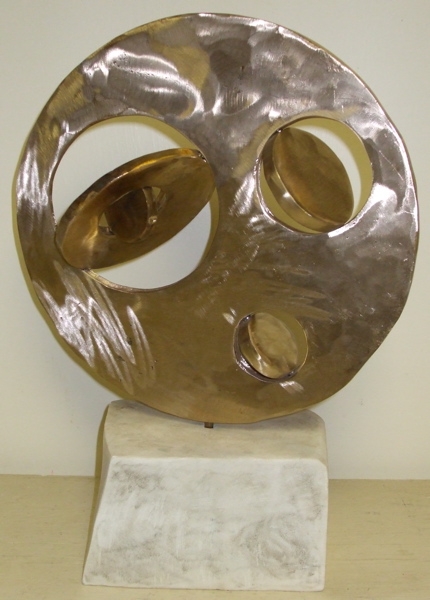
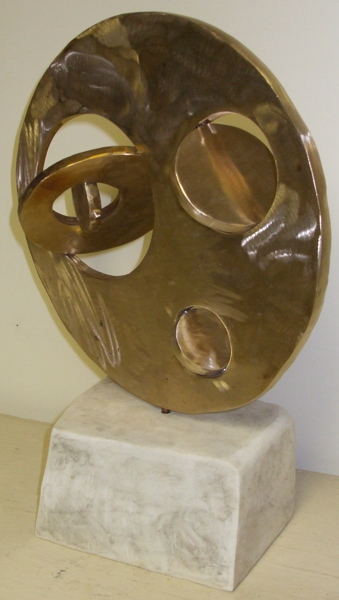
A bronze pour happened on April 16, 2010 at the Sculpture Studio at Binghamton University, and I made two new sculptures that day. One is a 3/4" diameter rod made into a (3,5) torus knot, and the other is a large Mobius trefoil knot made in three separate identical pieces to be welded together to make the final knot. If this design works well, it will be possible to make large steel versions by having the three separate sections made by bending and twisting straight pieces. I have started polishing these sculptures, but they are not yet done. Below are three pictures of the torus knot: partly polished, more fully polished, but in need of welding repairs, and after the welding repairs were done, in the final stages of polishing and mounted on a base of bluestone. The base is 12"x22"x2", and the bronze sculpture itself is approximately 13" in diameter. When struck it rings with an excellent tone. The last picture shows the three pieces which are supposed to fit together to form the Mobius Trefoil knot, but you can see that with the pieces clamped together roughly in two places, the third point is far from the correct position to complete the path. It seems that one of the pieces got bent out of the desired shape during the casting process or as wax, so I will have to bend it into the correct position. Who said art would be easy? The latest news on that incorrectly shaped third piece is that it broke when I tried to bend it, even though it had been heated to a cherry red by a torch. In order to fix this problem I will have to recast a third piece exactly the right size and shape to fit between the other two. That will have to wait until the next bronze pour in Fall 2010. I am continuing to experiment with thin pieces of aluminum and galvanized steel to see how this Mobius trefoil knot could be made as three identical pieces.
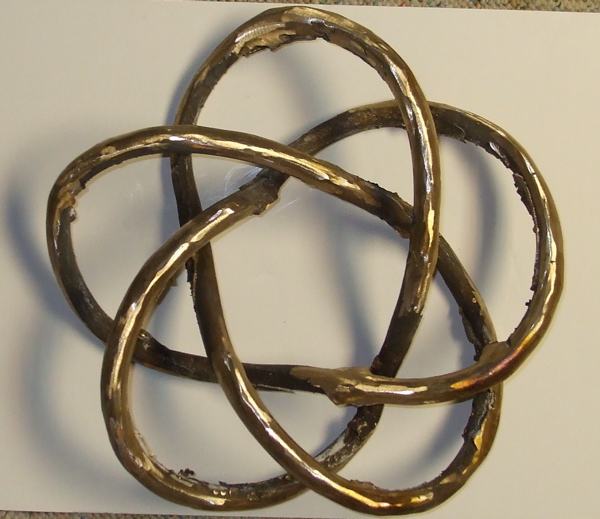
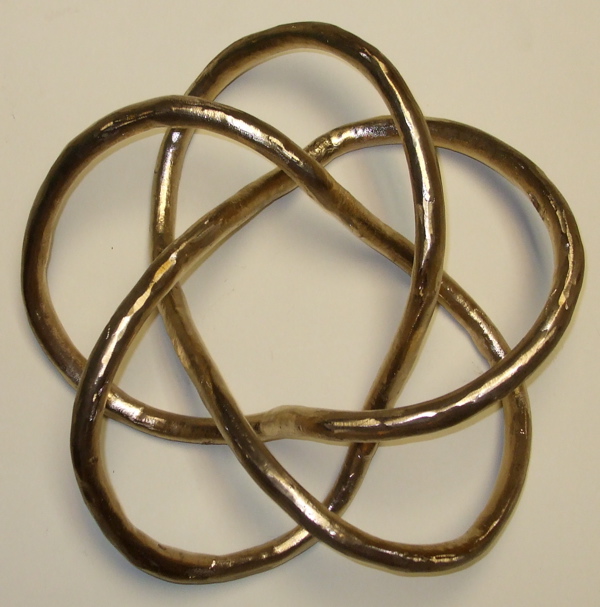
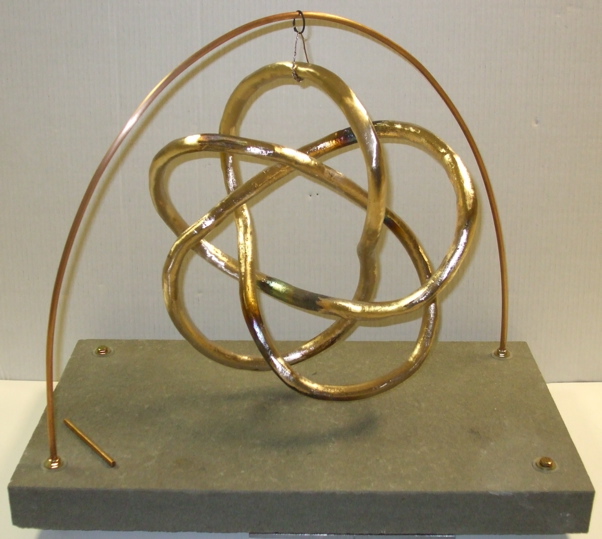
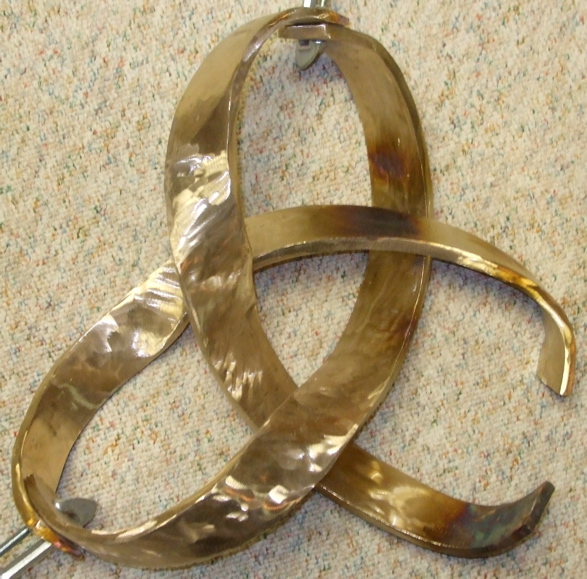
Below are three views of a new cocobolo wood carving I have made of a (4,4) torus knot. I left the corners of the original 6"x6"x2" block, so that it resembles a pinwheel, and it can stand on edge.
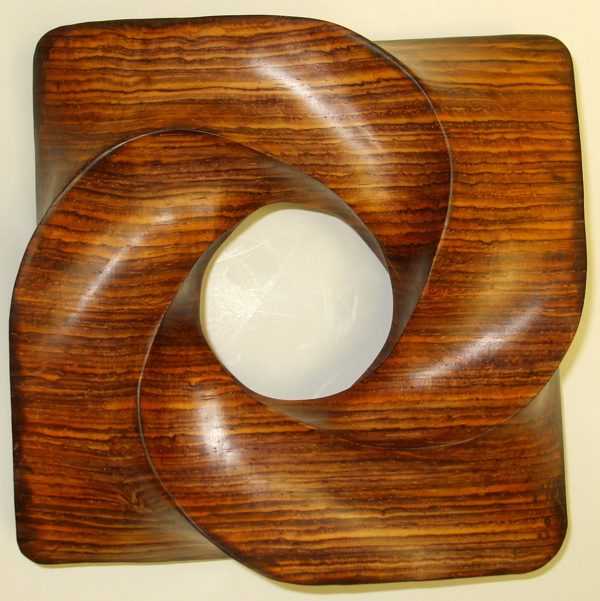
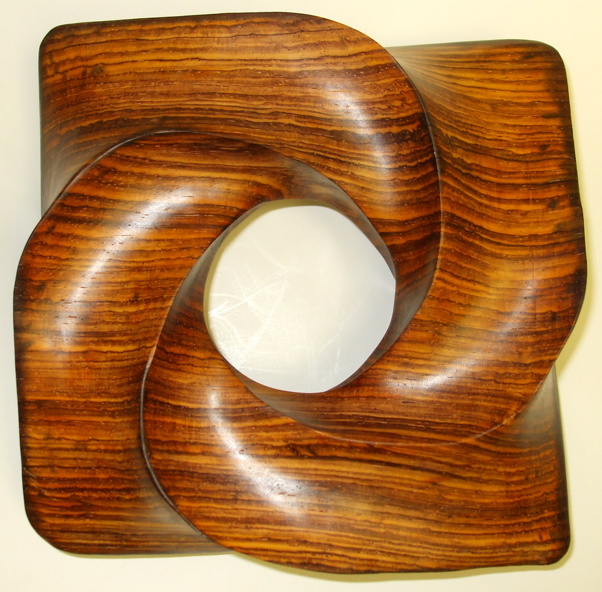
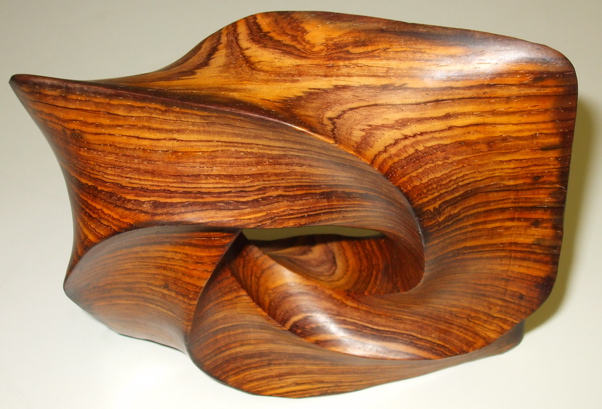
Here are three pictures of a new stripped ebony carving I have made of a (3,5) torus knot. This has a different appearance from the only other stripped ebony carving I have done, even though they are both (3,5) torus knots, because of the placement of the raised edge and curvature of the outside. It was made from a 6"x6"x2" block, and is now approximately 5.5" in diameter and 2" thick.
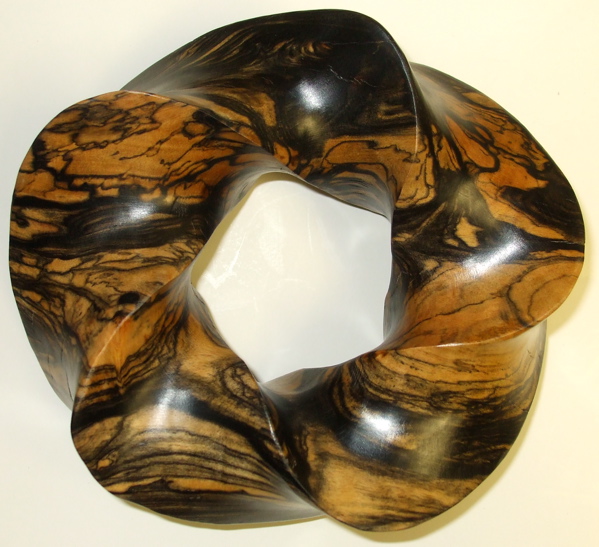
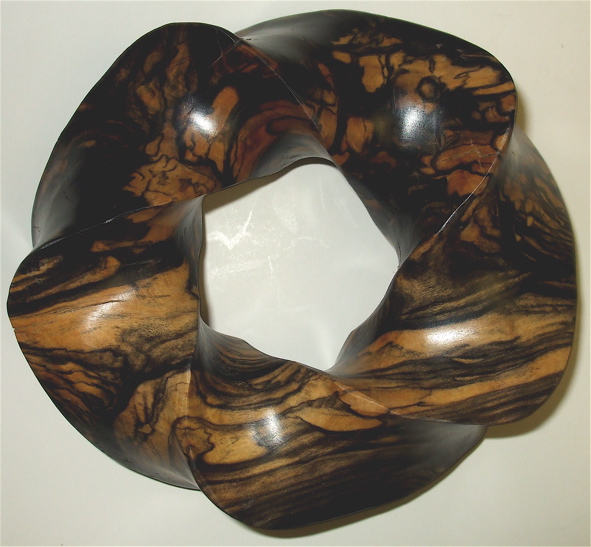
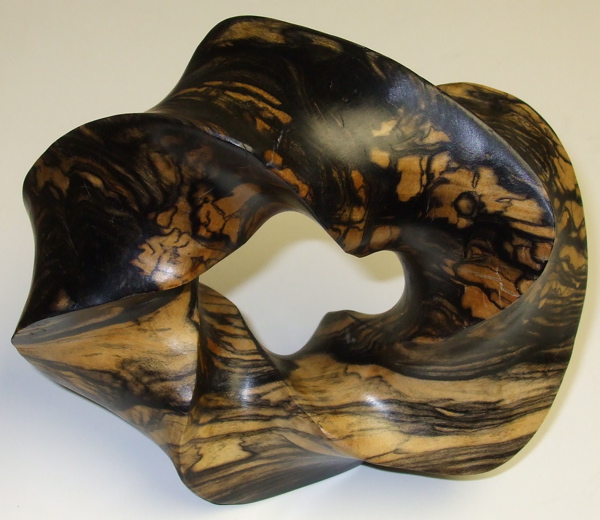
Here are three pictures of a new cocobolo carving I have made of a (4,5) torus knot. This has an especially beautiful grain.
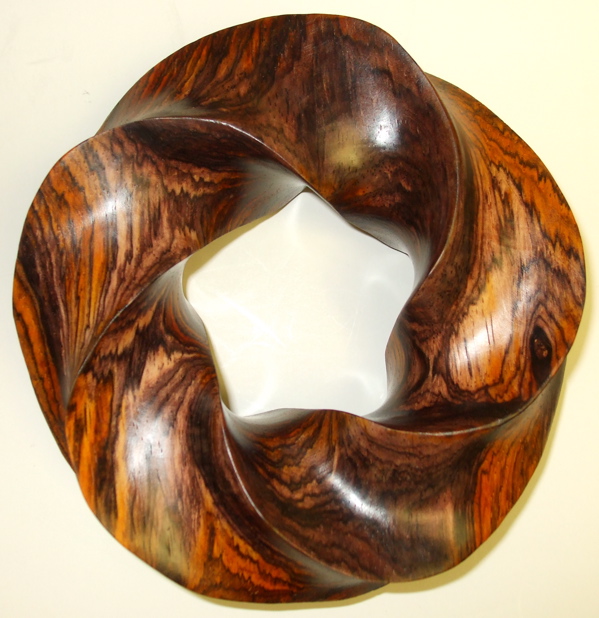
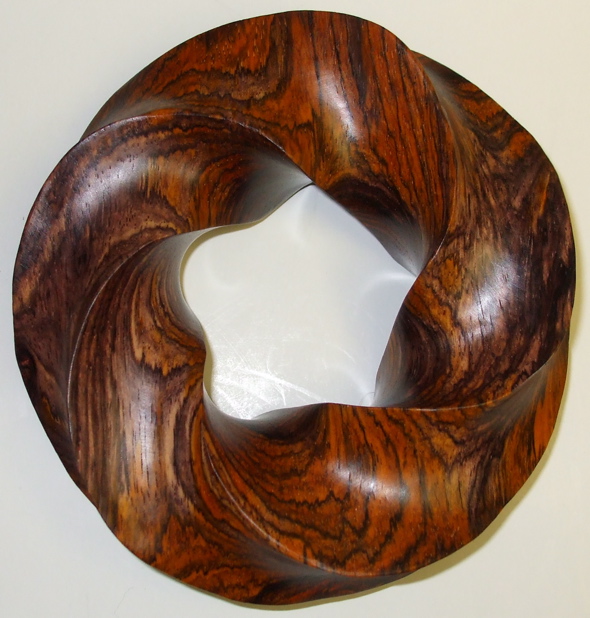
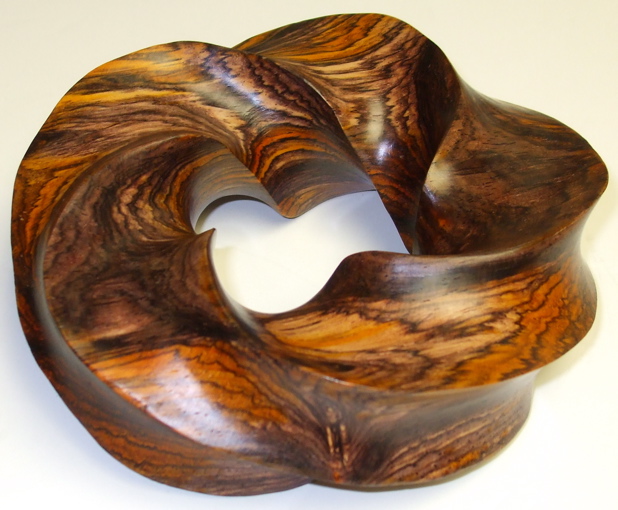
I finished a piece of Carara marble given to me by Helaman Ferguson, keeping to its main tetrahedral shape, but making the surfaces mostly concave. It was a scrap taken off of one of his larger sculptures, but it is plenty big enough for me. Here are pictures of it from several different angles. It has been completely polished, and looks rather like a shark tooth.
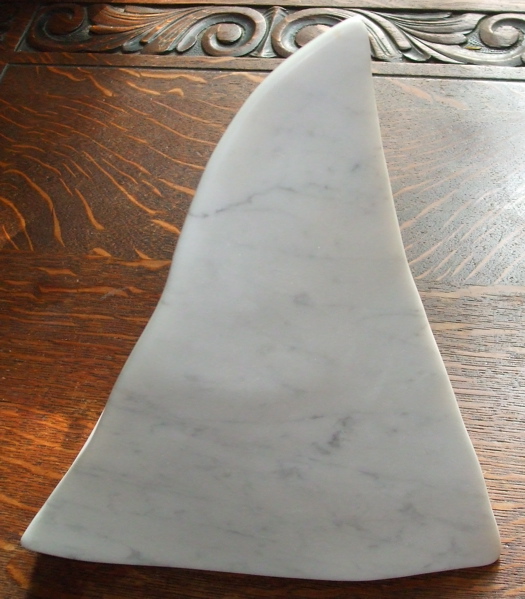
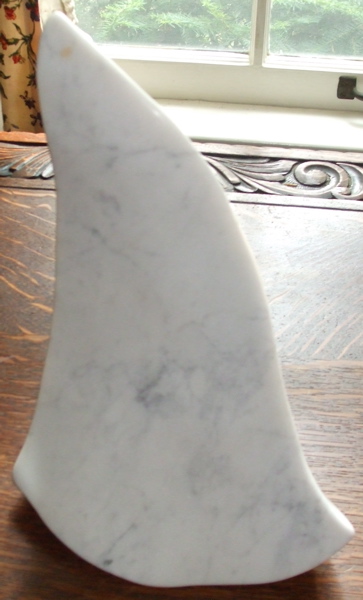
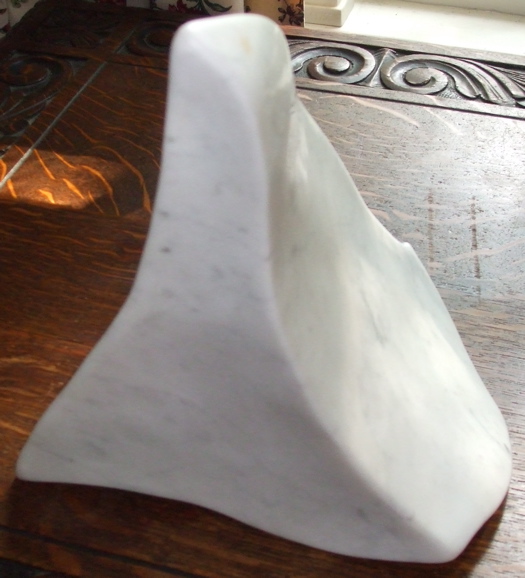
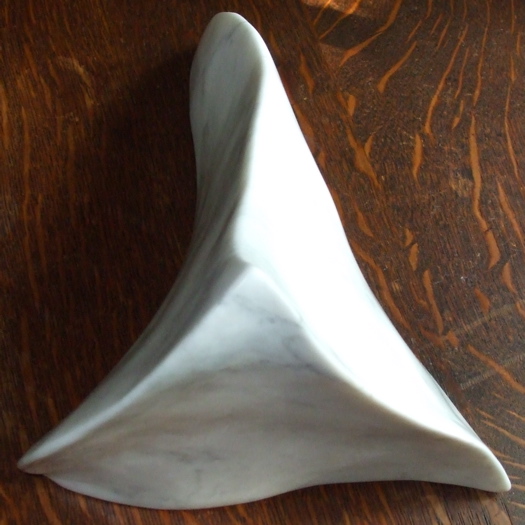
The (3,5) torus knot in cast bronze shown above on this page was made by the lost wax method. In order to position the wax rods in space I first made a 12" diameter torus out of clay (plastaline), then I made a plaster cast of that torus (two halves), and I used that plaster cast to make the torus out of mold material (plaster and sand). I made the 3/4" wax rods by pouring liquid wax into a vinyl tube 8' long, plugged on the end, immersed in boiling water so the wax would stay liquid and fill the tube without bubbles. When it cooled and solidified, I removed the wax from that tube by cutting the tube lengthwise and pealing it off the wax. The mold torus was heavy, but allowed me to position the wax rod evenly around the torus to make the (3,5) knot. Along with its gating, the entire result was immersed in a cylinder of mold material, which was then used in the rest of the casting process.
Since the plastaline torus was not damaged when I made its plaster cast, I decided to carve it into a (3,5) torus knot like the wooden ones I had done for another possible casting process, a sand mold used in an iron pour. Such a large knot would be rather expensive to cast in bronze, and a solid iron casting would be rather heavy. I made a new plaster cast of this plastaline torus knot, and used it to make a hydrocal casting of the knot. Hydrocal is a kind of plaster which dries to a hard white solid, often used for casting projects by students in the sculpture studio. The hydrocal torus knot I made is shown after some repairs and sanding in the following pictures. The plastaline model for it was unfortunately destroyed when I opened the plaster cast because of the deep curvature of the surface, which would not allow a clean release of the two halves. The was the reason I could not use this hydrocal model for a sand cast, so I did not make an iron casting of this 12" torus knot as I had hoped. I could remake the plastaline model for such an iron casting next year, but I am glad to have made this hydrocal version of this knot. It is possible to cover the surface with a metalic paint which would make it look like bronze, and even to make a patina on that painted surface, but the hydrocal has a certain appeal as it is.
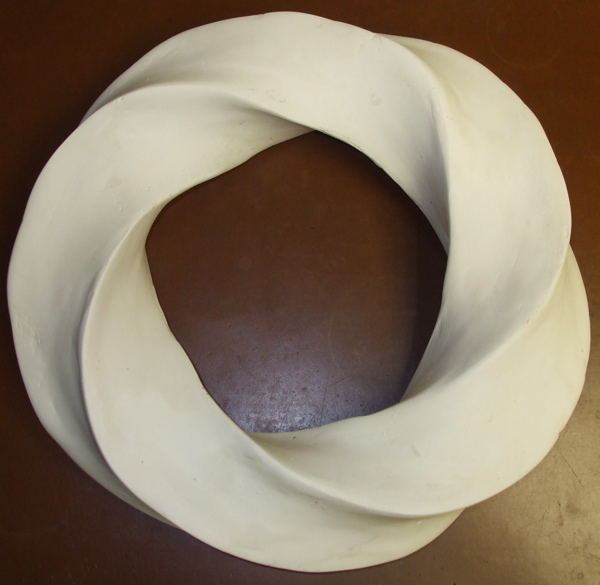
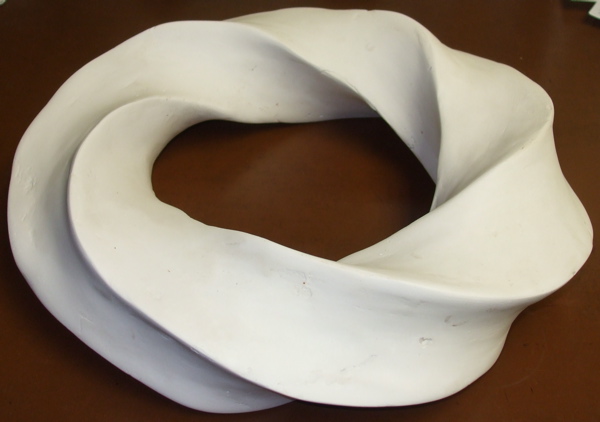
The alabaster torus knots shown at the top of this page were carved from rectangular blocks after the corners were rounded off and the center hole was cut out. I saved the corners and the cylindrical centers which were cut out for possible future use. The following pictures show simple carvings I made from those two central cylinders, each made into a short twisting tower, about 3" tall and 2.5" in diameter. A cross-section would be triangular but with curved sides, close to a hypocycloid.
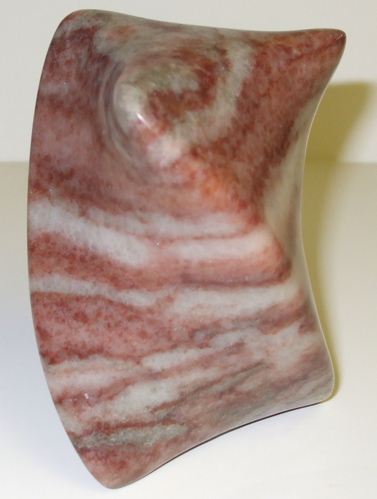
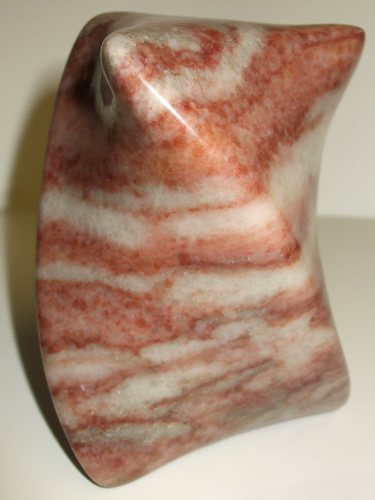
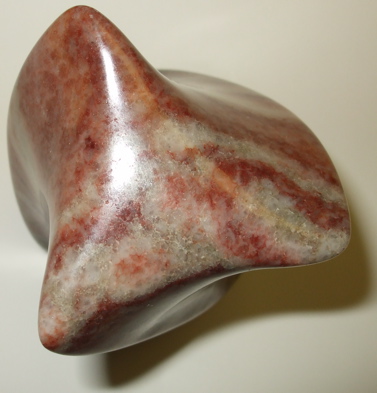
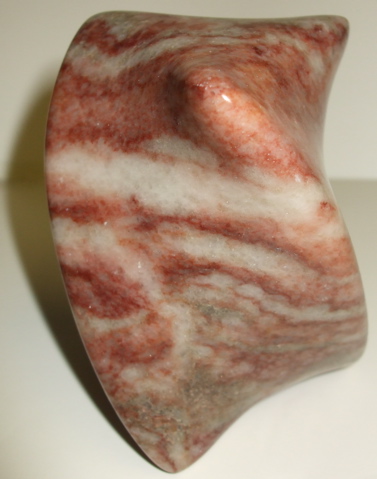
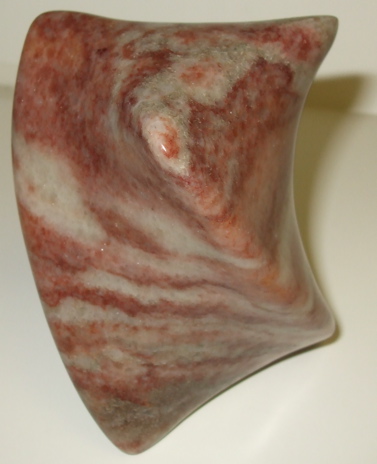
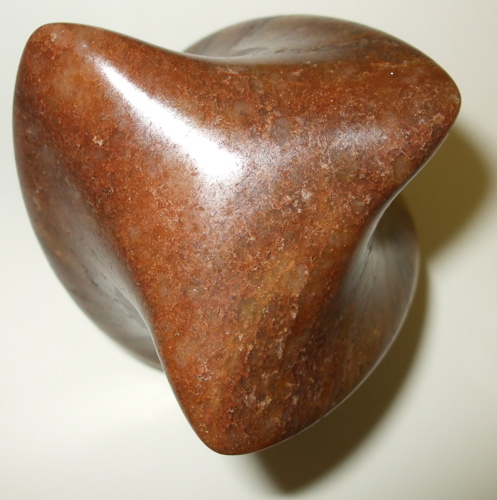
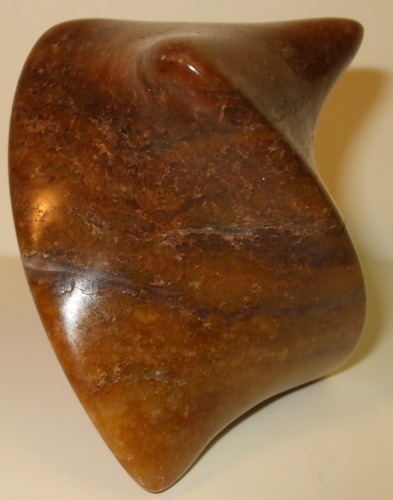
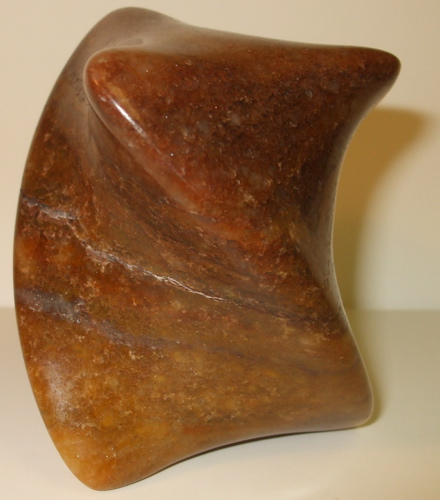
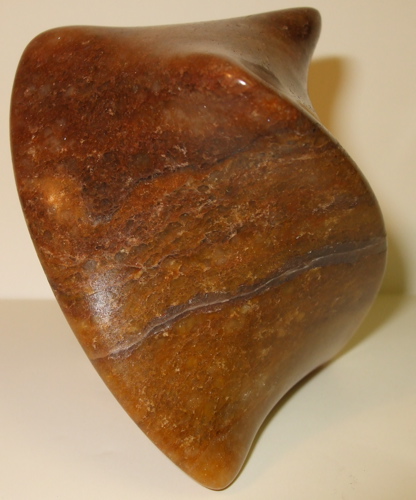
I also made such short twisted towers, about 2" tall and 1.75" in diameter, from the centers of cocobolo wood and black and white striped ebony. Pictures showing them from three sides are below.
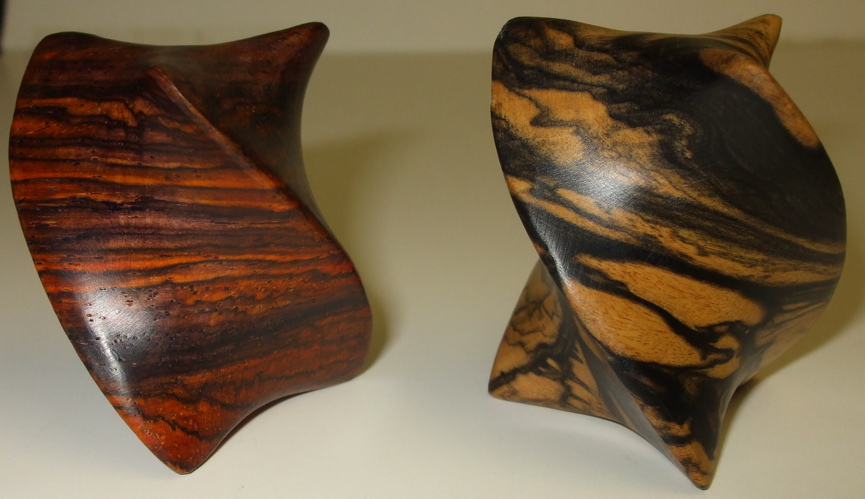
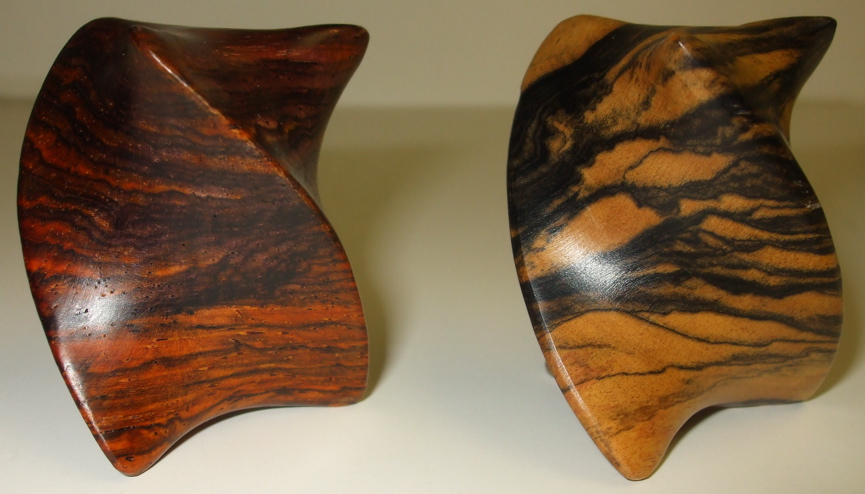
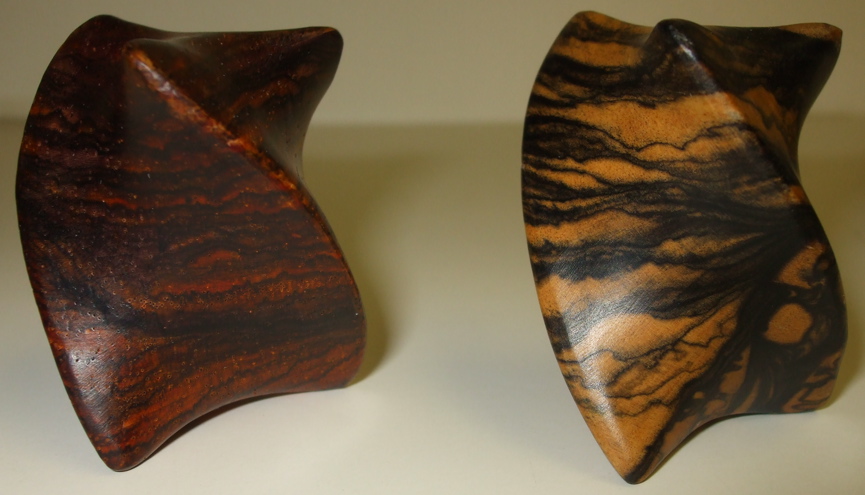
During my recent visit to celebrate Helaman Ferguson's 70th birthday, I got to tour his Baltimore sculpture studio. I noticed some small marble scraps, one a cube about 2" on a side, and another a rough torus about 5" in diameter. I thought this would be nice to carve into a torus knot and the cube could be a base. Helaman generously gave me these scraps as a ``birthday present", and below you see four views of the result (front, back, side, slightly above). I completed the polishing on 8-21-2010. I think this will be my last summer 2010 project.
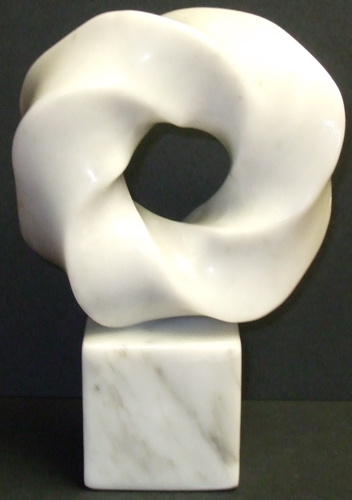
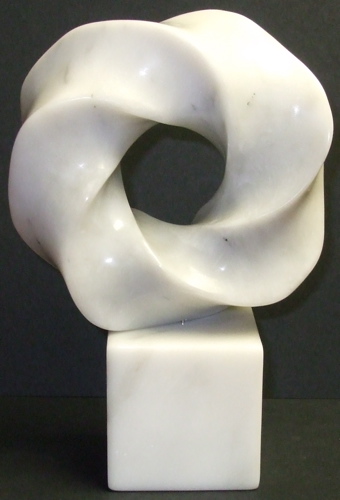
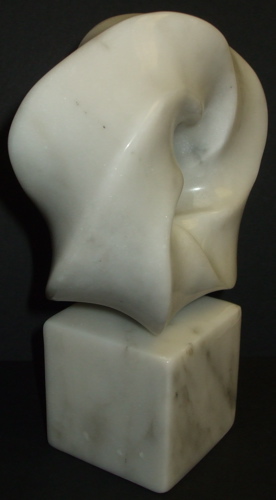
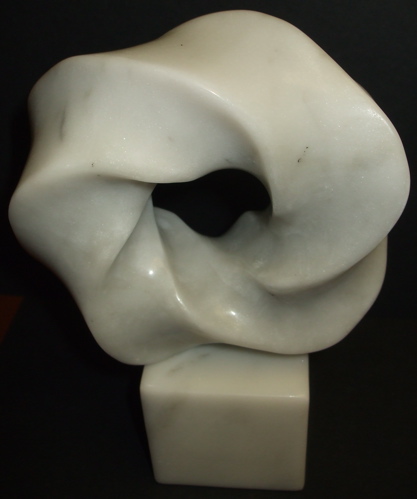
To see more types of sculpture I have tried, follow the following links:
Links back to:
Webpage of Alex Feingold,
Department of Mathematical Sciences,
Binghamton University.